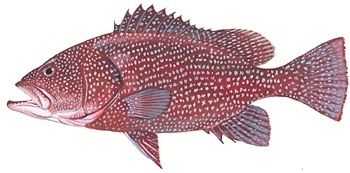Speckled Hind

Species Details
Epinephelus Drummondhayi
Serranidae
Perciformes
Nearshore, Ledges, Wreck
40 - 66 lbs.
35" - 47"
Speckled Hind (Epinephelus drummondhayi) Fish Description
Also known as Kitty Mitchell, Strawberry Grouper, or Calico Grouper, the Speckled Hind is a member of the Serranidae family along with sea basses and anthias.
The body of the Speckled Hind is compressed and robust; its color is reddish brown to grey and highly speckled with small white spots. Its outer pectoral fin is yellowish; in the juveniles, it is bright yellow with some bluish-white spots.
The Speckled Hind is one of those fishes that are not easily identifiable because it closely resembles other groupers like the Rock Hind, and the Red Hind.
Diet and Size
Some of the favorites of this predatory species are crustaceans like shrimps, lobsters, crabs. The Speckled Hind also feeds on squid, and fishes.
The Speckled Hind can grow up to 47 inches in length and weigh up to 66 pounds.
Interesting Facts About the Speckled Hind
- The first people to describe the Speckled Hind were ichthyologists Tarleton Bean and George Brown Goods in 1878 Florida. It is named after Lt. Col. Henry Drummond-Hay who discovered the said fish in Bermuda.
- The Speckled Hind is a protogynous hermaphrodite — meaning, the female later on becomes male. The female Speckled Hind matures at 4 or 5 years old. It transitions to male at age 7 to 14 years.
- This species of fish can live up to 80 years.
- Strangely, the Speckled Hind got one of its nicknames from a legendary hostess of a bawdy house in a fishing village in Florida.
- Stories said that Kitty Mitchell loved the fish too much that she would exchange it for her companionship with any fisherman who brings her the Speckled Hind.
Fishing Techniques: How to Catch a Speckled Hind
The Speckled Hind is usually a bycatch of commercial fishing for snappers (See Cubera Snapper, Mutton Snapper, Grey Snapper, Lane Snapper, Silk Snapper, and Red Snapper) and groupers (See Black Grouper, Snowy Grouper, Yellowedge Grouper, Yellowfin Grouper, and Spotted Grouper) especially in North Carolina. Recreational anglers target them, too; however, only one fish per boat per trip is allowed both for commercial and recreational purposes in the United States. Despite the regulations, this species is still being overfished or killed when returned to the sea wounded (due to barotraumas).
This species can be fished all-year round under established protocols. Recreational anglers must secure a license to harvest the Speckled Hind. As for commercial anglers, permit for reef fish is a must. Furthermore, the anglers must have a bottom longline endorsement for eastern Gulf reef fish.
For recreational anglers, natural baits must be used along with non-stainless steel circle hooks. A dehooking device is needed to remove hooks. The same protocols or measures apply to commercial anglers. The Speckled Hind can be effectively caught in waters as deep as 160 feet or more.
Habitat and Distribution
The Speckled Hind are naturally found offshore, particularly in coral reefs, subtidal aquatic beds, shallow seas, and open seas. They like areas with rocky substrates as deep as 200 to 390 feet. Young Speckled Hinds tend to swim in shallower waters. Sadly, this fish is threatened by loss of habitats.
The Speckled Hind are generally located off the eastern coast of North America and in Bermuda. Its range extends from North Carolina to the Florida Keys up to the Gulf of Mexico. Their spawning season is from April to September in the Gulf of Mexico. In others, their spawning season is from May to October.







